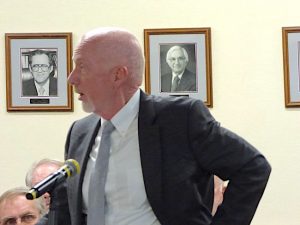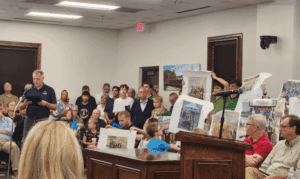
A proposed rezoning of 21 acres at Ga. Highway 54 and Carriage Lane for a commercial and residential development was tabled after the public hearing was held at the March 9 meeting of the Peachtree City Planning Commission.
The item was tabled due to late changes made to the proposal that did not give planning commissioners sufficient time to review. The suggestion to table was made at the outset by attorney Rick Lindsey, representing the developer, with commissioners taking that approach and voting to table the item after a partial presentation and public comments.
As originally proposed, the development would include an unspecified amount of commercial on 5.3 acres at the intersection of Hwy. 54 and Carriage Lane, and 154 townhomes situated on the remainder of the 21-acre property.
The initial rezoning proposed that 11 residential lots be converted to commercial space and 154 townhomes, though at the meeting a combination of townhomes and single-family homes was noted. Clarifying the changes, Lindsey after the meeting said the proposal now called for a total of 144 owner-occupied residences with no apartments and no rentals.
As for the commercial space, the applicant said it would take the form of a European village which, like that entirety of the development, would be upscale.
A check of the Fayette County tax map showed that the 11 residential lots carry a total fair market value of approximately $2.7 million.
All but two of the 14 people speaking in public comments were opposed to the proposed rezoning.
One of the speakers, nearby resident Nina Fallon, identified herself as a millennial who, along with her husband, had chosen Peachtree City as the place to raise their family. Questioning the proposal for more commercial space, Fallon noted the number of vacant storefronts already in evidence in the immediate area.
Also noting the trend of older people wanting to downsize, which is a trend both locally and nationwide, Fallon questioned if retirees would want to live between a state highway and a middle school. Her reference was to the planned re-location of Booth Middle School a short distance away on Carriage Lane.
Most speaking in public comments referenced the traffic burden that would be placed on the intersection of Carriage Lane and Hwy. 54. One of those was area resident Scott Austensen, who said the project sounded great, while noting the heavy impact of traffic, both with the proposed development and the plans of the Fayette County Board of Education to build the replacement Booth Middle School further down Carriage Lane.
Carriage Lane resident Kelly Ranes also posed concerns about traffic, noting the school system’s traffic study covering both Carriage Lane and nearby Stagecoach Road that gave poor grades to both intersections. The traffic study could not take into account the current development proposal.
The Citizen published an article on the traffic study on Sept. 29, 2019, which can be viewed here.
Beyond the low ratings received in the study, based on the projected 3,196 daily trips to and from the new Booth Middle School, the traffic study recommended splitting school traffic between Carriage Lane and the privately-owned Stagecoach Road.
Pertaining to the level of service (LOS), the Highway Capacity Manual defines six levels. Those are rate A-F, with “A” being the best and “F” being the worst.
The LOS rating for all three scenarios had morning and afternoon ratings for the intersections at Hwy. 54 and Robinson Road and Hwy. 54 at Carriage Lane showing a LOS of D or E.
For its part, Peachtree City Mayor Vanessa Fleisch at the Sept. 25, 2019 meeting of the Fayette County Board of Education opposed the location of the replacement Booth Middle on property between Carriage Lane and Stagecoach Road.
“Please accept this letter as formal notice of our opposition to the Stagecoach Road/Carriage Lane location for the construction of a proposed new middle school. With very limited improvement options, this site will place an undue burden on the transportation network in the immediate vicinity. Based on our previous experience, traffic improvements can easily reach millions of dollars with limited impact on mobility within the corridor. No such funds are included in the current or future Peachtree City budgets. Further, we request that a comprehensive traffic study be conducted that incorporates the impact of the school, along with proposed new development in the area, before a final decision is made on the location of a new school,” Fleisch said.













Leave a Comment
You must be logged in to post a comment.